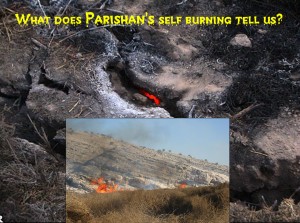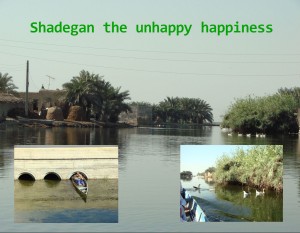Last week Iran’s nature took one of its finest sons and most refined adepts into its heart for ever. Pure body of Kambiz Bahram-Soltani was buried in the section 14 of “Behesht é Zahra” in the midst of the great sorrow of his bereaved friends and fans. He was the man who fought from Miankale to Kolah-ghazi and from Dena to Parishan, till his last breath for the love of the nature.
Last June, a day I will never forget, while walking on the desolate bed of Parishan, Bahram-Soltani was describing his devastation to me; “To see Parishan like this makes me Parishan, Darvish” he sighed. (Parishan means anguished distressed in Farsi).
He is not with us now to see how Parishan, the greatest body of sweet water in Iran, became even more dry , thanks to the indifference of you and me, stayed dry for so long until it chose to put an end to its agony and eventually gave in to self-burning.
In general, for what reason do whales commit suicide? Why do mountain goats jump off the highest cliffs and end their lives? Why do dolphins lose the way of the sea and choose to follow the path of death? is it not because they do not see any other way to prolonged existence?
Parishan was doomed to the same fate when its most important feeders the Barm flat and its surrounding mountain skirts were facing the worst nudity of their past 500 years and a total 80% of the marvelous oaks of Zagros Mountains have virtually dried out and vanished forever.
Despite such dire straits, we witness everyday that cultivation of horticultural and agricultural products on the under story of Barm clearly accelerates and plunders the very last ounces of moisture in the soil, leaving Parishan no chance whatsoever, to fill up its water springs and regain its life.
We also know that nearly one thousand illegal wells have been drilled to compensate for the excessively expanding agricultural lands and for the low level of precipitation, which of course does not make the situation any better.
On top of this, we should add the faulty decision of putting the Kazeroon combined-cycle power plant into operation, in such location that makes it an expropriating burden to Parishan knowing it would extract the very last drops of water from the lake for its cooling systems.
In the meanwhile, we hear that the new industrial town of Kazeroon is planned to be located in a way that its sewage might pose another threat, in terms of drinking water quality, to both Parishan plain and the city of Kazeroon.
This is why Parishan has been burning since last Wednesday, it committed self-burning the same way Soltan Abad é Shiraz (in Qareh daq) burned last year which resulted in a phenomenon that neither the present nor the past generation had seen and not even heard before.
In fact, what happens is that the lower layers of the soil in the wetland environment reaches an extent of dryness that the plant remnants, so called peat, decompose and produce methane gas faster than normal so that the soil can easily ignite as soon as the temperature rises to a certain level, and the fire spreads quickly to the entire area.
Therefore the over exploitation of the ground water aquifers, driven by a desire of being able to boast about self sufficiency in agriculture regardless of the price, is the reason behind the land subsidence and the resultant soil self immolation. Once all organic assets of the sub-surface beds are destroyed there will be no sign of soil or of the soil-born life.
Thus, developing sustainable consumption patterns, increasing irrigation efficiency in agriculture and reducing the waste rates in this sector, maintaining the livestock and pasture balance, inhibiting the operation of the intensive industrial centers as well as suspending bills such as “leisure agriculture”, and finally introducing alternative income options for farmers and ranchers are among the foremost measures that should be taken to reduce the dependency of livelihood on the land and to set the ground for the revival of the landscapes such as Parishan, Arjan, Barm, Zagros, Mianjangal; so that they could bring life back to the the local inhabitants of Fars province.


